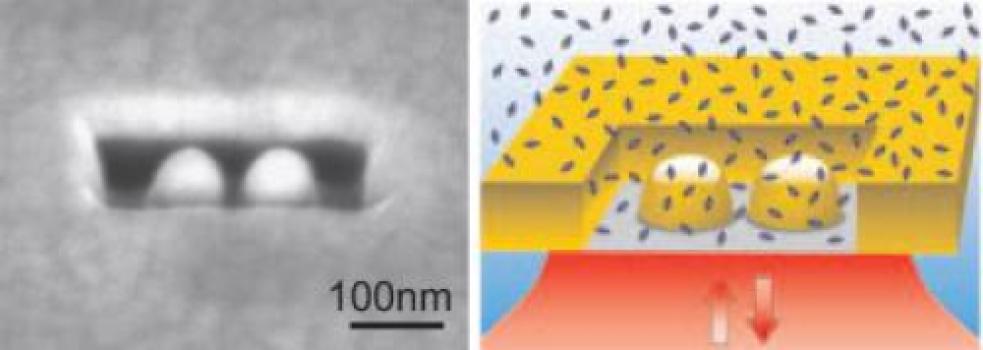Sensing individual biomolecules with optical sensors inside ‘nanoboxes’
June 12, 2013

A dimer (dual) sensor inside a “nanobox” for single-biomolecule analysis at high concentrations (credit: ICFO)
Researchers at the Fresnel Institute in Marseille and ICFO, Institute for Photonic Sciences in Barcelona have designed and built the smallest optical device capable of detecting and sensing individual biomolecules at concentrations similar to those found in cells.
The device consists on a tiny dimer (dual) sensor made out of two gold semi-spheres, separated from each other by a gap as small as 15nm (size of a protein molecule). Light sent to this antenna is enormously amplified in the gap region where the actual detection of the biomolecule of interest occurs. Because amplification of the light is confined to the dimensions of the gap, only molecules present in this tiny region are detected.
A second trick that the researchers used to make this device work was to embed the dimer antennas inside boxes also with nanoscale dimensions. “The box screens out the unwanted “noise” of millions of other surrounding molecules, reducing the background and improving as a whole the detection of individual biomolecules,.” explains Jerome Wenger from Fresnel Institute.
When tested under different sample concentrations, the device allowed for 1100-fold fluorescence brightness enhancement together with detection volumes down to 58 zeptoliters (1 zL = 10-21L), the smallest observation volume in the world.
The optical device offers a highly efficient platform for performing a multitude of nanoscale biochemical assessments with single-molecule sensitivity at physiological conditions. It could be used for ultrasensitive sensing of minute amounts of molecules, as an early diagnostic device for biosensing of many disease markers.
“It can also be used as an ultra-bright optical nanosource to illuminate molecular processes in living cells and ultimately visualize how individual biomolecules interact with each other. This brings us closer to the long awaited dream of biologists,” says ICFO researcher Prof. Maria Garcia-Parajo.